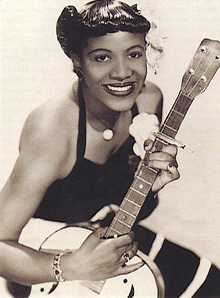Bea Booze
| Bea Booze | |
|---|---|
 | |
| Background information | |
| Birth name | Beatrice Booze |
| Born |
March 23, 1912 Baltimore, Maryland, United States |
| Died |
November 1986 (age 74) Scottsville, New York, U.S. |
| Genres | R&B, jazz |
| Occupation(s) | Singer, musician |
| Instruments | Vocals, guitar |
| Years active | 1930s–1950s |
| Labels | Decca |
| Associated acts |
Sammy Price Andy Kirk |
Bea Booze (March 23, 1912 - November 1986), often credited as Wee Bea Booze, was an American R&B and jazz singer most popular in the 1940s.
Biography
She was born Beatrice Booze[1] in Baltimore, the daughter of Phillip Booze and his wife Lydia.[2] She made her name as a singer in Harlem, New York. She was signed by Decca Records to cover the songs and emulate the style of Lil Green,[3] and, under the guidance of Sammy Price, first recorded in 1942. Her version of "See See Rider Blues", first recorded by Ma Rainey, reached number 1 on the R&B chart, after which she was billed as "The See See Rider Blues Girl". As well as singing, she played guitar in performance and on many of her recordings.
Later in the 1940s, Booze recorded as a jazz vocalist with the Andy Kirk band,[3] which featured trumpeter Fats Navarro, and also with a jazz quartet that included saxophonist George Kelly and organist Larry Johnson. She retired from the music business in the early 1950s to settle first in Baltimore and later in Scottsville, New York, although she recorded with Sammy Price in 1962.[3] She died in Scottsville in 1986.[1]
Confusion with Muriel Nichols
For reasons that remain undocumented, producer J. Mayo Williams, who knew Bea Booze from his time with Decca, released a version of "See See Rider" sung by Muriel Nichols for his Harlem label as number 1003 in 1945, credited to "Muriel (Bea Booze) Nichols". Though Nichols, born in Philadelphia in 1908, was a different singer, this led to the false belief, reported in many sources, that Bea Booze's real name was Muriel Nichols. Instead, Booze was listed in the 1920 US census as a 7-year old, born in Baltimore, Maryland, on March 23, 1912.[1]
References
- ↑ 1.0 1.1 1.2 Paulus, George, Campbell, Robert, Pruter, Robert Ebony, Chicago, Southern, and Harlem: The Mayo Williams Indies Retrieved Sept. 22, 2014
- ↑ Ancestry.com. 1920 United States Federal Census, Baltimore Ward 17, Baltimore (Independent City), Maryland; Roll: T625_663; Page: 5B; Enumeration District: 296; Image: 145.
- ↑ 3.0 3.1 3.2 Harris, Sheldon (1994). Blues Who's Who (revised edition), New York: Da Capo Press, p. 61. ISBN 0-306-80155-8.
External links
|